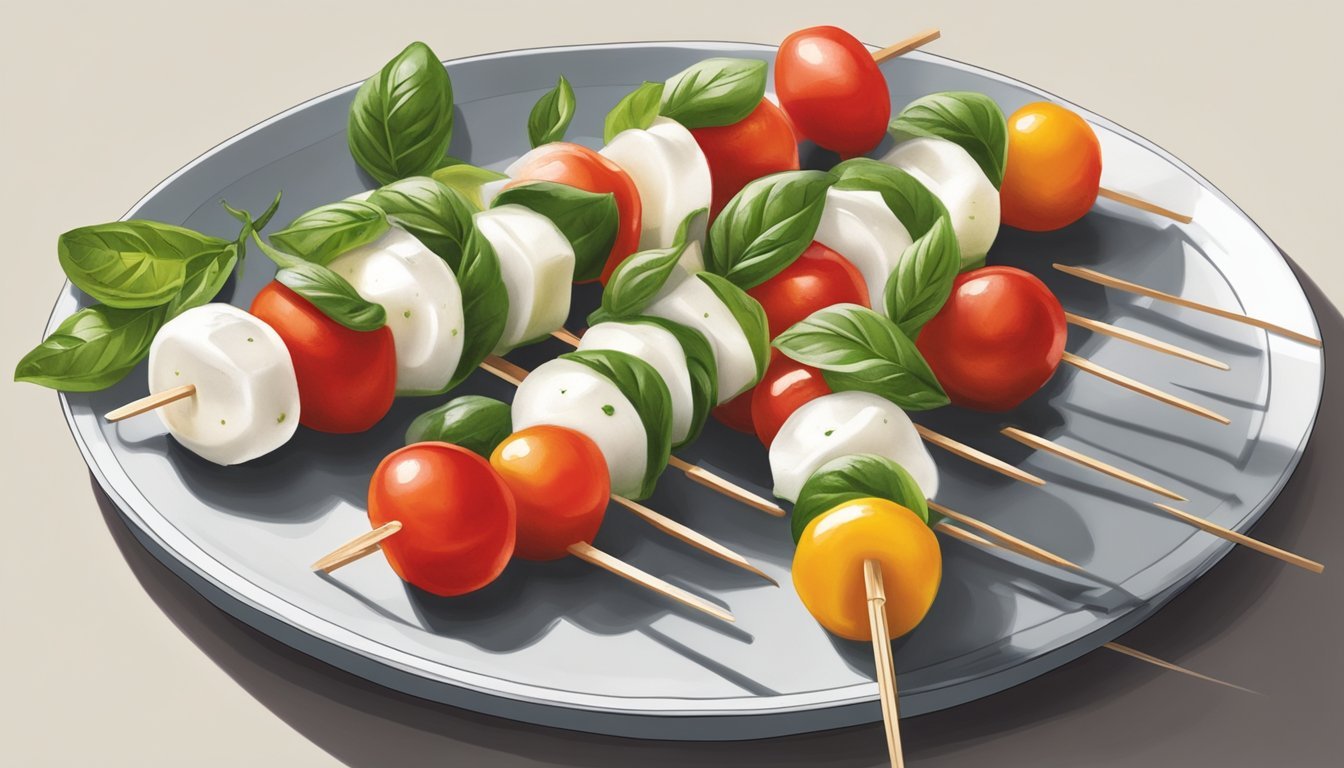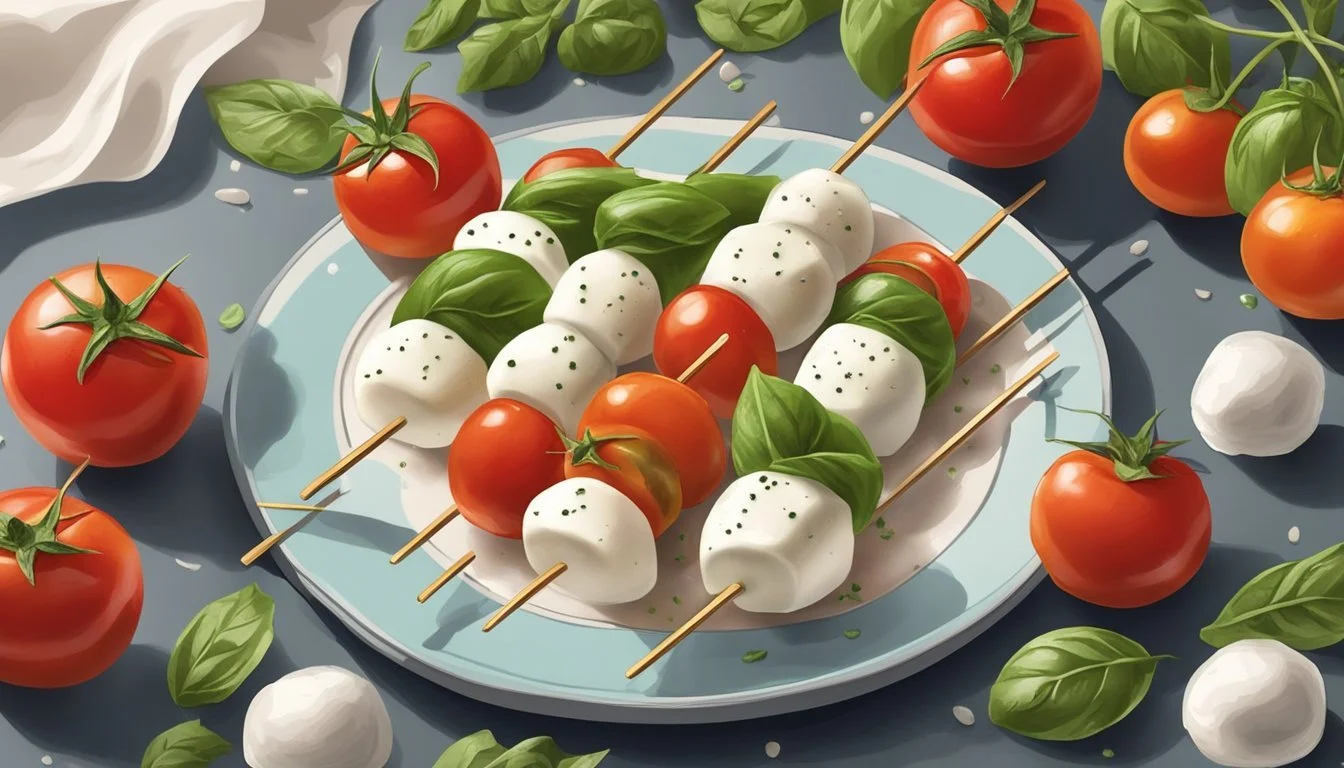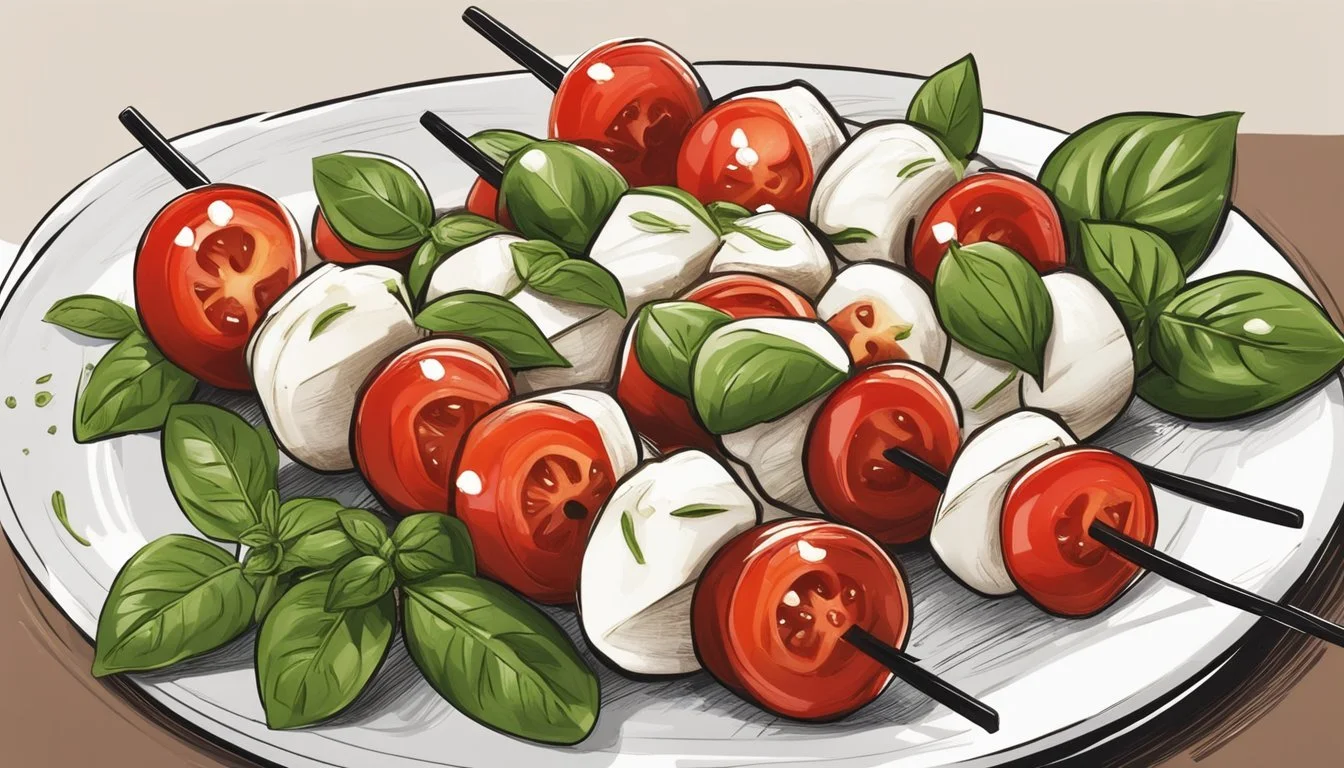Best Way to Reheat Caprese Skewers
Ensuring Juicy Tomatoes and Soft Mozzarella
Caprese skewers offer a delightful blend of ripe cherry tomatoes, creamy mozzarella, and fresh basil, often finished with a drizzle of rich balsamic glaze. They are a go-to for gatherings and a favorite for their simplicity and fresh flavor. However, serving them at the ideal temperature is crucial for maintaining the juiciness of the tomatoes and the softness of the mozzarella. Reheating them improperly can lead to a less than appetizing texture and compromised taste.
To reheat caprese skewers while preserving their desirable qualities, care must be taken to gently warm the ingredients without cooking them further. Tomatoes should retain their burst of juice, and mozzarella must stay soft and pliable, reflecting the textural contrast that makes these skewers so appealing. The essence of basil acts as a fragrant backdrop, its flavor drawn out subtly during the gentle warming process, while the balsamic should complement without overpowering the delicate balance of the skewer components.
Given the cold nature of traditionally served caprese skewers, it's important to approach the reheating process with a strategy that respects the individual ingredients. Each element plays a fundamental role in the overall experience, thus ensuring each is treated with care will result in reheated caprese skewers that are as enjoyable as when they were freshly made.
Understanding Caprese Skewers
Caprese skewers are an ingenious way to present the classic flavors of a traditional Italian caprese salad in a convenient and party-friendly format. They are fresh, colorful, and can be composed with a few quality ingredients assembled on a skewer.
Essential Ingredients
Tomatoes: Cherry tomatoes are ideal for their size, juiciness, and sweetness.
Mozzarella: Small mozzarella balls, also known as bocconcini, are soft, creamy, and perfect for skewering.
Basil: Fresh basil leaves contribute a fragrant aroma and a hint of green.
Olive Oil: A drizzle of olive oil adds richness and helps to bring out the flavors of the other ingredients.
Balsamic Glaze: This sweet and tangy reduction provides a characteristic finishing touch.
The Composition of a Caprese Skewer
The construction of a caprese skewer is straightforward:
Start with a cherry tomato, piercing it onto the skewer.
Follow with a fresh basil leaf, often folded to fit neatly.
Add a mozzarella ball to balance the flavors.
Repeat the pattern until the skewer is filled, usually with 3–4 sets of ingredients per skewer.
Each skewer is then arranged on a platter, offering a bite-sized taste of the Italian classic that is both visually appealing and easy to eat. These skewers are commonly served as an appetizer at gatherings, highlighting a fresh and vibrant selection for party-goers.
Preparation Techniques
The preparation of Caprese skewers hinges on the freshness and quality of the produce as well as the precision in the assembly of the skewers. Ensuring cherry tomatoes are juicy and mozzarella remains soft is instrumental in maintaining the appeal and flavor of the dish.
Washing and Cutting Produce
They begin by thoroughly washing the cherry tomatoes to preserve their natural sweetness and ensure hygiene. The tomatoes should be dried carefully to prevent dilution of flavors. It is often recommended to select sweet cherry tomatoes for their burst of flavor and firmness that holds well when skewered. If large mozzarella balls are being used, one should cut them into smaller cubes approximately the same size as the tomatoes to ensure uniformity and ease of eating.
Assembling the Skewers
When assembling the skewers, they use toothpicks or small skewers for easy handling. Each skewer typically features a cherry tomato, a fresh basil leaf, and a piece of mozzarella. The basil leaves may need to be folded if they are large to fit the scale of the skewers properly. They ensure the skewers are assembled just before serving to maintain the freshness and prevent the mozzarella from becoming tough. The Caprese skewers are appreciated for their ease of preparation, with a total prep time that is usually under 20 minutes, leading to a simple yet delicious appetizer.
Reheating Methods
Reheating Caprese skewers carefully preserves the fresh flavors of juicy tomatoes and soft mozzarella. The following methods aim to maintain the integrity of the summer dish while ensuring it remains quick to prepare and delicious.
Using a Microwave
To reheat in a microwave, one must strike a balance to keep the tomatoes juicy and mozzarella soft. Place the skewers on a microwave-safe plate, cover them with a damp paper towel to distribute heat evenly, and use low power in short intervals, checking often to avoid overheating.
Oven-Based Reheating
Oven-based reheating provides a more even and gentle warming than a microwave. Preheat the oven to a low temperature, around 200°F (93°C). Lay skewers on a wire rack over a baking sheet, tent with foil to keep moisture in, and heat just until the mozzarella is adequately soft.
Skillet Warming
For those preferring to use a stovetop, skillet warming is an option. Heat a non-stick skillet on low heat. Add the skewers, cover with a lid, and allow the residual heat to warm them through. The mozzarella should become pliable, but not melt entirely.
Alternative Techniques
For a make-ahead summer gathering, there are alternative techniques to consider. If the skewers were marinated in olive oil, let them come to room temperature for approximately 20 minutes before serving or lightly warm them on a grill for a smoky accent. Store in an airtight container to retain freshness until ready to reheat.
Maintaining Quality and Safety
When reheating Caprese skewers, it is crucial to preserve the juiciness of the tomatoes and the softness of the mozzarella. Following proper storage and safety procedures ensures the skewers are both delicious and safe to consume.
Storing Leftovers
Leftover Caprese skewers should be stored carefully to maintain their quality. The refrigerator is the best place to keep them fresh. One should:
Place the skewers on a serving platter or another flat dish if they plan to serve them again soon.
Cover the dish tightly with plastic wrap or transfer the skewers to an airtight container to protect them from air exposure.
Refrigerate the leftovers promptly, ideally within 2 hours of initial serving to prevent bacterial growth.
Best Practices for Food Safety
Food safety is paramount when handling fresh ingredients such as fresh mozzarella balls and cherry tomatoes. To ensure safety:
Never leave Caprese skewers at room temperature for more than 2 hours.
Always use clean utensils and a clean serving platter to avoid cross-contamination.
If a balsamic reduction or any other sauce was used, one should store it separately and only drizzle it over the skewers before serving, not before refrigerating.
By following these guidelines, one can safely enjoy their Caprese skewers for a subsequent meal.
Enhancing Flavor After Reheating
After reheating Caprese skewers, one can enhance their flavor by applying dressings and drizzles, and by adding fresh elements. These additions complement the warm tomatoes and soft mozzarella, reviving the appetizer's appeal.
Dressings and Drizzles
To reintroduce a zesty freshness to Caprese skewers, balsamic reduction or balsamic glaze can be drizzled on top. The density and sweetness of reduced balsamic vinegar contrasts with the tangy flavor of the tomato while enhancing the creaminess of the mozzarella.
Balsamic Reduction: A drizzle of balsamic reduction adds a concentrated sweet and tangy flavor.
Extra Virgin Olive Oil: A light drizzle of olive oil can reintroduce a fruity richness to the skewers.
Adding Fresh Elements
Incorporating fresh basil and seasoning such as freshly ground black pepper and sea salt can brighten the overall taste of the skewers. Fresh elements should be added after reheating to preserve their texture and flavor.
Fresh Basil: Place a fresh basil leaf between the tomato and mozzarella to introduce a peppery note.
Seasonings: A pinch of sea salt and freshly ground black pepper can emphasize the natural flavors of the ingredients.
Serving Suggestions
Caprese skewers, when reheated properly, provide a delicious blend of juicy tomatoes and soft mozzarella that can elevate any gathering. For best results, serve these skewers warm, unless a chilled appetizer is desired.
Pairings and Combinations
When considering what to pair with Caprese skewers, one should select items that complement the fresh and mild flavors of the dish.
Side Dishes: A light arugula salad or couscous can accompany the skewers as a side dish.
Appetizers: (What wine goes well with appetizers?) For a variety of appetizers, serve alongside bruschetta topped with pesto or prosciutto-wrapped melon.
Complimentary Flavors: Adding a small dish of pesto for dipping can enhance the skewers' flavor.
Presentation for Gatherings
Presentation is key when serving Caprese skewers at a party or gathering.
Platters: Arranging the skewers on a large serving platter allows guests to easily help themselves.
Immediate Service: To maintain the integrity of the ingredients, it's advisable to serve the skewers immediately after reheating.
Garnishes: For an added touch, garnish the platter with a few fresh basil leaves or a drizzle of balsamic glaze.
Nutritional Information
When considering the reheating of Caprese skewers, understanding their nutritional value is important. The components consist of cherry tomatoes, mozzarella cheese, basil leaves, and occasionally a drizzle of balsamic glaze or olive oil—ingredients that contribute to the overall macronutrient and micronutrient content of the dish.
Caloric and Macromolecular Content
Caprese skewers are primarily composed of carbohydrates from tomatoes, protein and fat from mozzarella, and trace amounts of other macronutrients. A single skewer may have roughly:
Calories: 20-30 kcal
Protein: 1-2g
Carbohydrates: 1-3g
Sugars: 1-2g (from tomatoes and potential balsamic glaze)
Fiber: 0.5-1g
Fat: 1-2g
Saturated Fat: ≤1g
These values can vary depending on the size of the skewer and the amount of cheese and balsamic glaze used.
Dietary Considerations
Caprese skewers offer a gluten-free and often low-carb option suitable for many dietary preferences. They are:
Naturally gluten-free, assuming no cross-contamination.
Typically low in sodium, unless additional salt is added.
Possible to be low-carb, depending on portion size.
However, they do contain dairy, which may not be appropriate for individuals with lactose intolerance or those following a vegan diet.
Micronutrient Profile
These skewers include a range of vitamins and minerals:
Tomatoes: Rich in vitamin C, potassium, and vitamin A.
Mozzarella: Provides calcium and phosphorus, essential for bone health.
Basil: Offers additional micronutrients, such as vitamin K and iron.
It's worth noting that any additional condiments or dressings can alter the nutritional profile slightly, by increasing the sugar, sodium, or fat content.
Caprese Skewers Variations
Caprese skewers are extremely versatile, providing the perfect canvas for a myriad of flavor combinations. The key to delightful variations lies in selecting the right cheese and adding complementary vegetables or meats.
Cheese Alternatives
Caprese skewers traditionally feature mozzarella pearls or bocconcini, small mozzarella balls that pair well with cherry tomatoes and basil. For a richer texture and flavor, one could also utilize goat cheese, which adds a tangy aspect to the skewers. It's important to choose cheeses that maintain their integrity when at room temperature to keep the appetizer's structure.
Classic: Mini mozzarella balls or mozzarella pearls
Tangy Alternative: Goat cheese chunks or soft cubes
Vegetable and Meat Additions
Incorporating additional vegetables and meats can elevate the complexity of caprese skewers. For a fresh take, adding olives introduces a briny contrast to the sweetness of the tomatoes. Those seeking to incorporate meat might opt for prosciutto, a thin Italian ham, which complements the flavors with its savory and slightly salty taste. Seasonings like Italian seasoning or fresh garlic can also be sprinkled or rubbed onto the cheese for an aromatic touch.
Vegetable Add-Ons: Pitted olives or sun-dried tomatoes
Meat Pairings: Slices of prosciutto or salami










